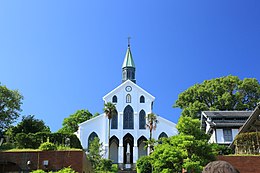
Back Skrytá křesťanská místa regionu Nagasaki Czech Verborgene christliche Stätten in der Region Nagasaki German Sitios de los cristianos ocultos en la región de Nagasaki Spanish سایتهای مسیحیان پنهان در منطقه ناگاساکی Persian Nagasakin alueen salaiset kristityt paikat Finnish Sites chrétiens cachés de la région de Nagasaki French אתרים נוצריים נסתרים בחבל נגסאקי HE Tajna kršćanska mjesta regije Nagasaki Croatian Siti cristiani nascosti della regione di Nagasaki Italian 長崎と天草地方の潜伏キリシタン関連遺産 Japanese
| UNESCO World Heritage Site | |
|---|---|
 Ōura Cathedral | |
| Location | Nagasaki and Kumamoto, Japan |
| Criteria | Cultural: iii |
| Reference | 1495 |
| Inscription | 2018 (42nd Session) |
| Area | 5,566.55 ha |
| Buffer zone | 12,252.52 ha |
| Coordinates | 32°44′03″N 129°52′13″E / 32.734106°N 129.870236°E |
Hidden Christian Sites in the Nagasaki Region (Japanese: 長崎と天草地方の潜伏キリシタン関連遺産) is a group of twelve sites in Nagasaki Prefecture and Kumamoto Prefecture relating to the history of Christianity in Japan. The Nagasaki churches are unique in the sense that each tells a story about the revival of Christianity after a long period of official suppression.[1]
Proposed jointly in 2007 for inscription on the UNESCO World Heritage List under criteria ii, iii, iv, v, and vi, the submission named at the time Churches and Christian Sites in Nagasaki on the Tentative List, was recognized on January 30, 2018, as a World Heritage Site.
The initial nomination included 26 sites; however, after reconsideration the Nagasaki Prefecture reduced the monuments to 13 sites.[2] Twelve sites were recognized. Concerns over the Hidden Christian Sites in the Nagasaki Region have been widely discussed in the academic literature.[3]
- ^ "Churches and Christian Sites in Nagasaki". UNESCO. Retrieved September 21, 2011.
- ^ "Churches and Christian Sites in Nagasaki". UNESCO.; "Outline of Churches and Christian Sites". Nagasaki Prefecture. Retrieved 29 July 2014.
- ^ Delakorda Kawashima, Tinka (2017). "Landscape in Hirado revealing the secrets of Hidden Christians' life-world: National and global policies in cultural heritage protection" (PDF). Anthropological Notebooks. 23 (3). Slovene Anthropological Society: 87–107. ISSN 1408-032X.
